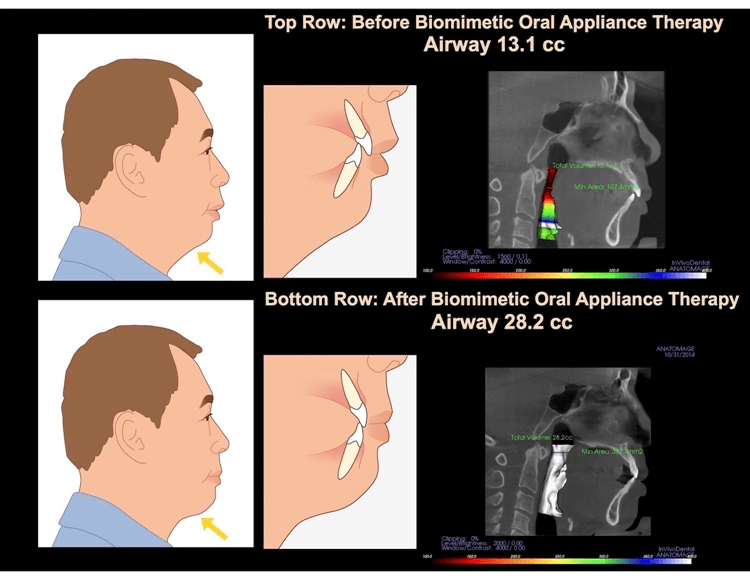If you grind your teeth when you sleep, you may have been told that there’s not much you can do about it besides wear a night guard. But while a guard can certainly protect your teeth, it does nothing to address the cause.
Over the years, various theories on the causes of bruxism have been proposed and debated, from stress to a misaligned bite to parasitic infections. But one has started getting a little bit more attention of late: obstructive sleep apnea, or OSA.
OSA means that you wake repeatedly through the night whenever your airway becomes blocked and your brain isn’t getting the oxygen it requires. If you’re overweight, it could be excess tissue around the top of the trachea that falls back as you relax. For many, though, it can be the consequence of narrow dental arches that don’t provide enough room in the mouth to comfortably contain the tongue. As you relax, your lower jaw can slide back, pulling the tongue back with it to block the airway.
What does this have to do with bruxism?
As Houston sleep medicine specialist Jerald H. Simmons has noted, teeth grinding may in fact be “a response to protect the airway in situations where there is a vulnerability towards airway collapse.” The movement is an attempt to unblock the airway. It gets the jaw shifting forward, opening the airway so you can breathe freely again.
One especially interesting study compared sleep studies of OSA patients with and without the help of a CPAP device to keep the airway clear and open.
During the CPAP titration night most breathing abnormalities were eliminated and a complete eradication of the tooth grinding events was observed. The results of this study suggest that when sleep bruxism is related to apnea/hypopneas, the successful treatment of these breathing abnormalities may eliminate bruxism during sleep. [emphasis added]
But as we’ve mentioned before, CPAP is hardly the only solution for mild to moderate OSA. Often, oral appliance therapy that holds the lower jaw forward can be enough to help you keep breathing through the night. And now we can provide appliance therapy that can actually reshape and enlarge the airway itself: the DNA appliance.
Once, folks thought it was next to impossible to redevelop the airway in adults, after the skull and jaws were fully developed. The DNA appliance works by stimulating stem cells that remain in the jaw, triggering them to spur new growth. The arches widen, allowing more room for the tongue. The windpipe widens, allowing more air to reach the lungs with each breath.
Take a look at the before and after images below, from Dr. Felix Liao’s Three-Foot Tiger, Six-Foot Cage, a book which, along with his follow-up Early Sirens, provides an excellent and comprehensive introduction to the relationship between airway and oral-systemic health. Red indicates a pinched airway; the further down the spectrum toward white, the more open the airway.

As you can see, the difference can be profound.
Coupled with myofunctional therapy, diet, and lifestyle chances, the DNA appliance is a real game-changer when it comes to improving health. Research has linked OSA with many systemic health problems, including high blood pressure, chronic inflammation, cardiovascular issues, cognitive impairment, and more.
We’re pleased to be able to offer this new therapeutic option to our patients.
If you suspect bruxing or OSA is a problem for you, give us a call to set up an appointment for an exam. We’ll do a visual exam, as well as 3D imaging of your jaws and adjacent structures so we can evaluate the state of your airway. We’ll talk with you at length about your oral and systemic health histories and concerns so we can make an accurate diagnosis of your problem and offer a custom, individualized solution, whether the DNA appliance or another option.
Everything depends on the individual – and correctly assessing the cause of any pain or dysfunction so we can treat the root causes and not just the symptoms.
Teeth image by Joel Penner, via Flickr